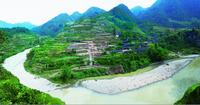You are in: Asia -> China -> Tusi Sites, and traditional search or Image Gallery will yield results of this site only
Tusi Sites
| Site number: | 1474 |
|
| Type of site: | Cultural | |
| Date: | 13-20 century | |
| Date of Inscription: | 2015 | |
| Location: | Asia, China, Laosicheng, Tangya and Hailongtun | |
Up to 75 images are shown here. Click on each for more details or on Image Gallery for more images.
Six official UN languages:
Chinese,
English,
French
Other languages: Czech, Italian, Portuguese, Swedish, Vietnamese
Other languages: Czech, Italian, Portuguese, Swedish, Vietnamese
| Description: | Located in the mountainous areas of south-west China, this property encompasses remains of several tribal domains whose chiefs were appointed by the central government as ‘Tusi’, hereditary rulers from the 13th to the early 20thcentury. The Tusi system arose from the ethnic minorities’ dynastic systems of government dating back to the 3rd century BCE. Its purpose was to unify national administration, while allowing ethnic minorities to retain their customs and way of life. The sites of Laosicheng, Tangya and Hailongtun Fortress that make up the site bear exceptional testimony to this form of governance, which derived from the Chinese civilization of the Yuan and Ming periods. --WHMNet's description is from WHC Site, where additional information is available. | |
| Tusi Sites (Chinese: 土司遗址; Pinyin: Tǔsī YíZhǐ) are sections of the ancient Tusi sites that have been designated by the UNESCO as World Heritage Sites. On July 3, 2015, Tusi Sites were listed as World Heritage Site. It is the 48th World Heritage Site in China. --Wikipedia. Text is available under the Creative Commons Attribution-ShareAlike License. | ||
| Source: | http://whc.unesco.org/en/list/1474 | |
| Source2: | Wikipedia (http://wikipedia.com) | |
| Reference: | 1. UNESCO World Heritage Center (http://whc.unesco.org/en/list/1474). 2. Wikipedia. | |









